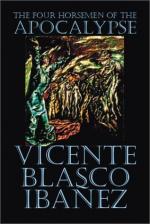In gratitude for these eulogies, she felt that she ought to show some interest in his affairs. . . . What had he been doing of late?
“I, Madame, have been where I ought to be. I have not budged from this spot. I have witnessed the siege of Paris.”
In vain, his reason protested against the inexactitude of that word, “siege.” Under the influence of his readings about the war of 1870, he had classed as a siege all those events which had developed near Paris during the course of the battle of the Marne.
He pointed modestly to a diploma in a gold frame hanging above the piano against a tricolored flag. It was one of the papers sold in the streets, a certificate of residence in the Capital during the week of danger. He had filled in the blanks with his name and description of his person; and at the foot were very conspicuous the signatures of two residents of the rue de la Pompe—a tavern-keeper, and a friend of the concierge. The district Commissary of Police, with stamp and seal, had guaranteed the respectability of these honorable witnesses. Nobody could remain in doubt, after such precautions, as to whether he had or had not witnessed the siege of Paris. He had such incredulous friends! . . .
In order to bring the scene more dramatically before his amiable listener, he recalled the most striking of his impressions for her special benefit. Once, in broad daylight, he had seen a flock of sheep in the boulevard near the Madeleine. Their tread had resounded through the deserted streets like echoes from the city of the dead. He was the only pedestrian on the sidewalks thronged with cats and dogs.
His military recollections excited him like tales of glory.
“I have seen the march of the soldiers from Morocco. . . . I have seen the Zouaves in automobiles!”
The very night that Julio had gone to Bordeaux, he had wandered around till sunrise, traversing half of Paris, from the Lion of Belfort, to the Gare de l’Est. Twenty thousand men, with all their campaign outfit, coming from Morocco, had disembarked at Marseilles and arrived at the Capital, making part of the trip by rail and the rest afoot. They had come to take part in the great battle then beginning. They were troops composed of Europeans and Africans. The vanguard, on entering through the Orleans gate, had swung into rhythmic pace, thus crossing half Paris toward the Gare de l’Est where the trains were waiting for them.
The people of Paris had seen squadrons from Tunis with theatrical uniforms, mounted on horses, nervous and fleet, Moors with yellow turbans, Senegalese with black faces and scarlet caps, colonial artillerymen, and light infantry from Africa. These were professional warriors, soldiers who in times of peace, led a life of continual fighting in the colonies—men with energetic profiles, bronzed faces and the eyes of beasts of prey. They had remained motionlesss in the streets for hours at a time, until room could be found for them in the military trains. . . . And Argensola had followed this armed, impassive mass of humanity from the boulevards, talking with the officials, and listening to the primitive cries of the African warriors who had never seen Paris, and who passed through it without curiosity, asking where the enemy was.




